We fall into step with this trio from Nar – the elderly Chitr is accompanied by a friend, Tashi, and a young girl called Dolkar – as we are all heading to the tiny village of Meta, where tomorrow our paths will separate. We will walk two more days north to the village of Phu; the others will take the path northeast to Nar.
How Indonesians beat mining companies to help create a Unesco Global Geopark
How Indonesians beat mining companies to help create a Unesco Global Geopark
We climb above the pale, gushing river, stopping regularly to share snacks.
Meta is sheltered by the Kusum Kanguru mountain and stands at the end of a steep, twisting path. At 3,500 metres (11,483ft) above sea level, Meta is used as a winter settlement by the people of Nar – 700 metres higher – due to its “warmer” climate.
As we arrive at the handful of stone houses, Chitr herds us into a dark kitchen attached to a basic trekking lodge. Before I sit down, a smiling lady wearing a navy fleece and flowered headscarf thrusts a cup of black tea into my hand and a bowl of steaming noodles under my nose.
This is Phurbu Chumo, Chitr’s daughter, and this is her lodge. Fortunately she has a vacancy.
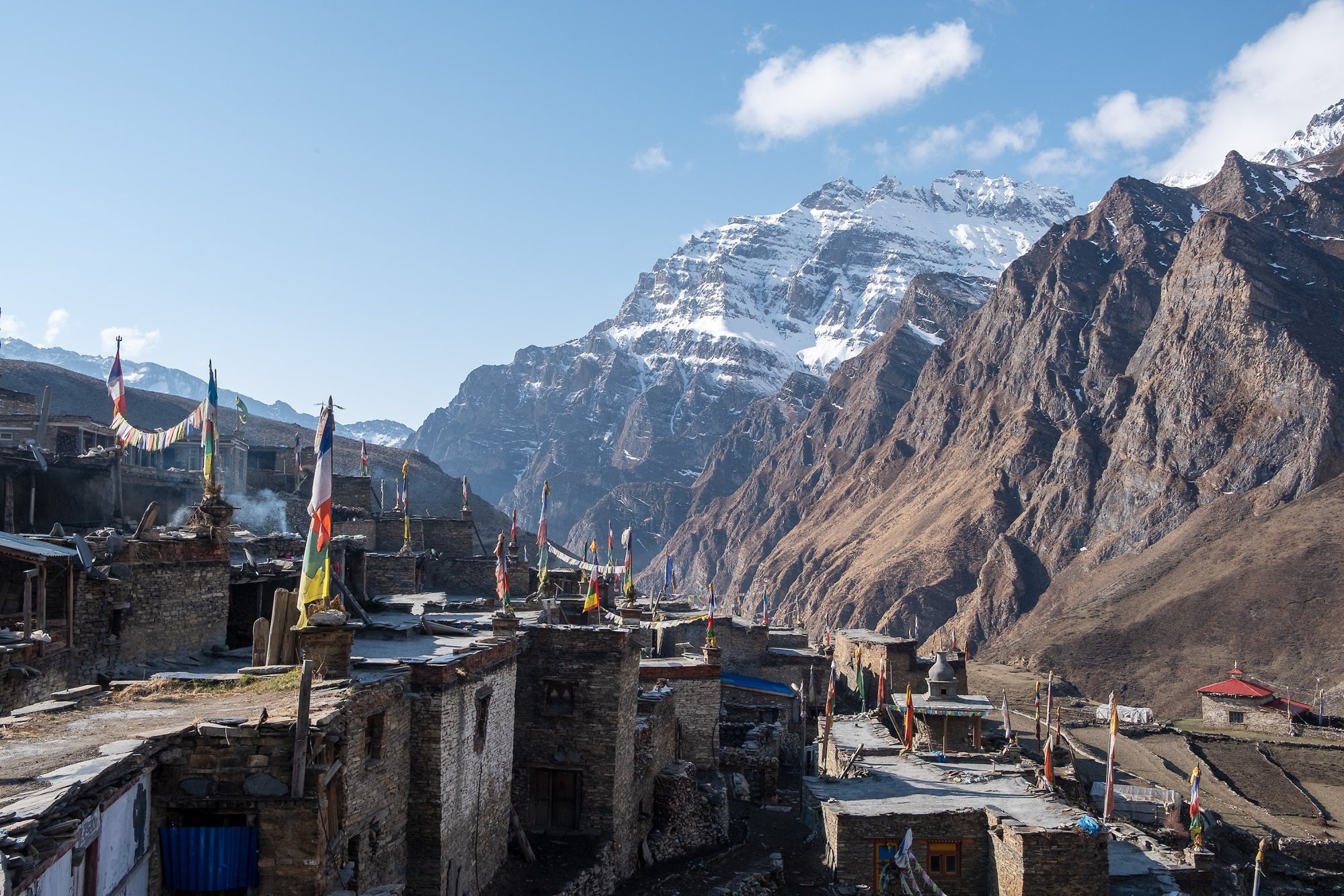
Similar to all lodges in the area, it offers basic rooms with plywood walls and thin mattresses on unsteady wooden bedframes. Toilets are shared, buckets of warm water available on request.
That evening, we eat Phurbu’s momos in the kitchen, on benches set around a stove, above which strips of blackened meat hang to dry.
Chitr and Tashi talk of the days when the people of Nar and Phu had to journey for weeks on foot to lowland areas in winter to sell jimbu (a Himalayan herb) and incense. But life is easier now, they say; Nar is only one day’s walk from the road and they bring supplies in by yak.
From Meta, we continue up the Phu Valley, through goat pastures and tiny stone settlements. On the opposite side of the river, grazing grounds are squeezed onto plateaus between the water and the rock above.

In Chyakhu, a few lodges – temporary accommodation for tradespeople and men working on the installation of Wi-fi infrastructure, as well as the occasional tourist – stand below a deserted stone village and the ruins of buildings erected by Tibetan Khampas.
During the 1960s, the Khampas – guerillas who fought against the Chinese – entered northern Nepal, including around Nar and Phu. They stayed for many years, building rows of houses and clearing swathes of land for agriculture; the outlines of their terraces and water channels are still visible in Chyakhu.
Not far past the settlement, the path enters a golden gorge. In places, it has been carved into the bare, rocky cliffs; elsewhere, the path crosses precariously loose, impermanent slopes. For hours the gorge continues to narrow in a land devoid of human habitation as the trail winds, climbs and undulates its way to Phu.
Eventually, we are forced from the gorge up a sandy, winding path. At the top of this small pass are the red doors to the valley of Phu. In times gone by, the sturdy doors were locked every night by the villagers of Phu to keep out thieves and marauders. Nearby, a solitary lookout tower is in ruins.
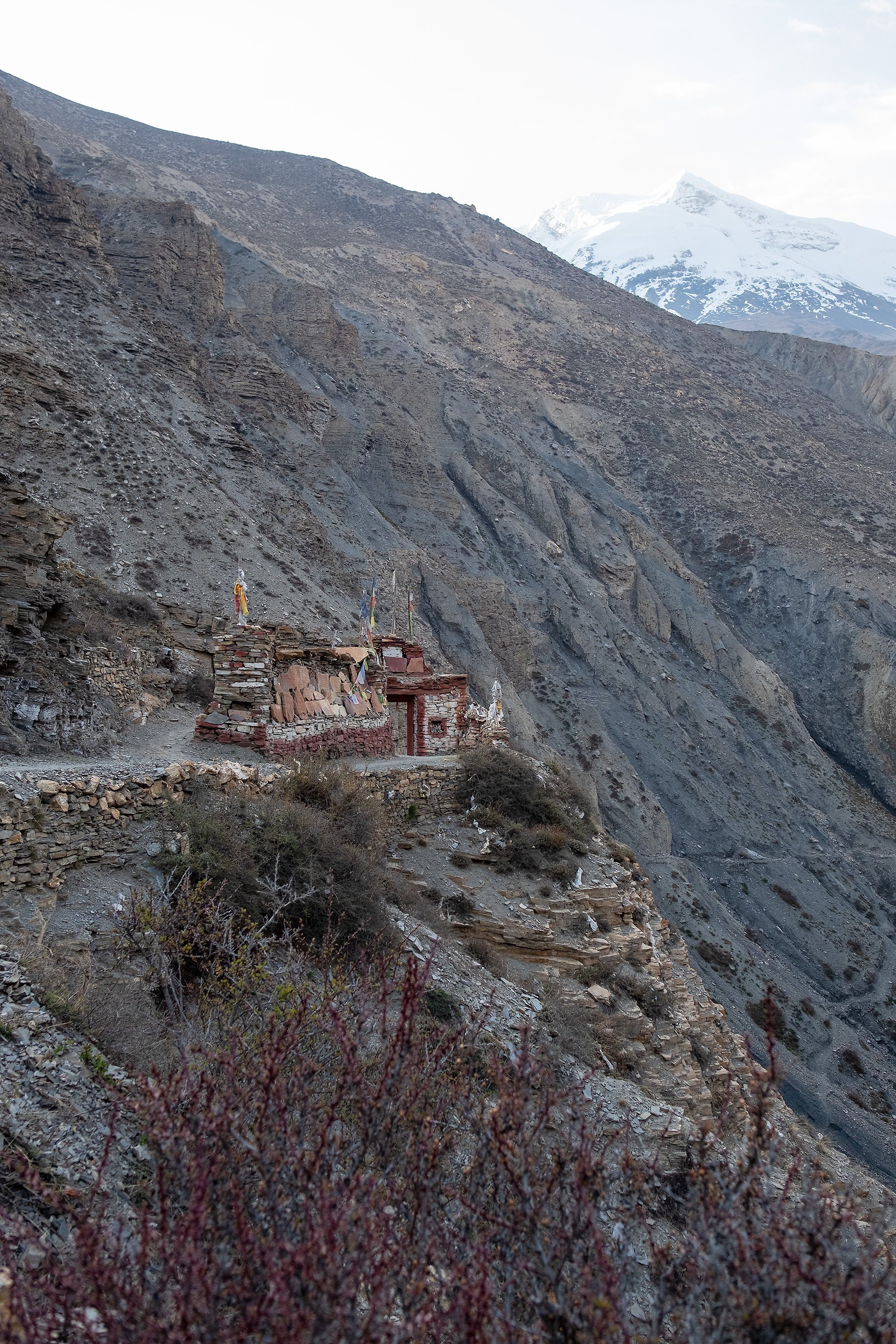
We enter the valley and a barren, wild landscape, although colourful mani walls and crumbling chortens (shrines) mark the path to the village.
When we reach Phu – less than 15km from the Tibetan border – grey clouds have filled the sky and a fearsome wind is whipping through the quiet lanes. Most residents are shepherds, we are told, and are now high on the mountains with their yaks.
The village is built in a U-shape into a hollow of a hill, across which residents shout to each other in communication. Most houses are on the more sheltered southern side, with the opposite side mostly covered by flat terraces that are used to dry barley.
One of two old ladies sitting fingering prayer beads below the old citadel tells me there are fewer than 100 people living here now but, “there were many people here when I was young”.
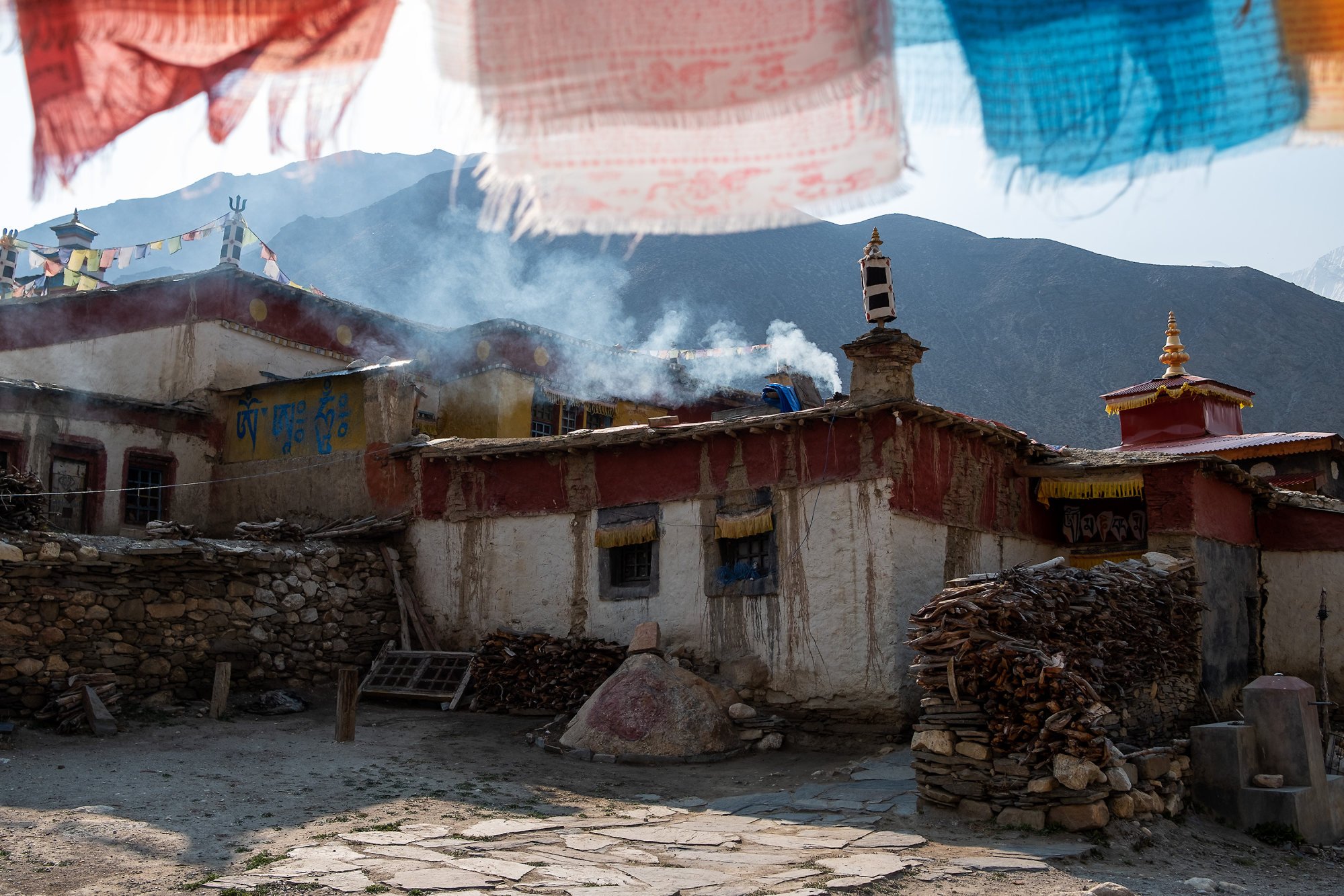
Several women stand around the village tap, chatting. One tells us cheerily that she is off to check on her animals and darts off up a steep path, at a ferocious speed, spinning wool with her fingers, palms and a stick all the while.
As in Nar, the people here are Tibetan Buddhists, and Phu’s main monastery, Tashi Lhakhang Gompa, sits on a solitary hill. Said to have been picked for its auspicious shape, the mound is criss-crossed with lines of prayer flags – some brightly coloured but most faded with age – strung between chortens and wooden posts. Rocks marked with blue Tibetan characters sit among the crumbling red and white chortens.
“It feels like home in Phu,” says Jamphe Lama, who is from the Kham region of Tibet and is the resident lama at this 650-year-old gompa (temple or monastery). “Everything here is more similar to Tibet than to Nepal – the people, the weather, the culture.”
From the gompa, the trail to Tibet can be seen meandering off into the folds of an arid valley. Snowy peaks glitter in the morning sun and Jamphe points to a triangular mountain up the valley.
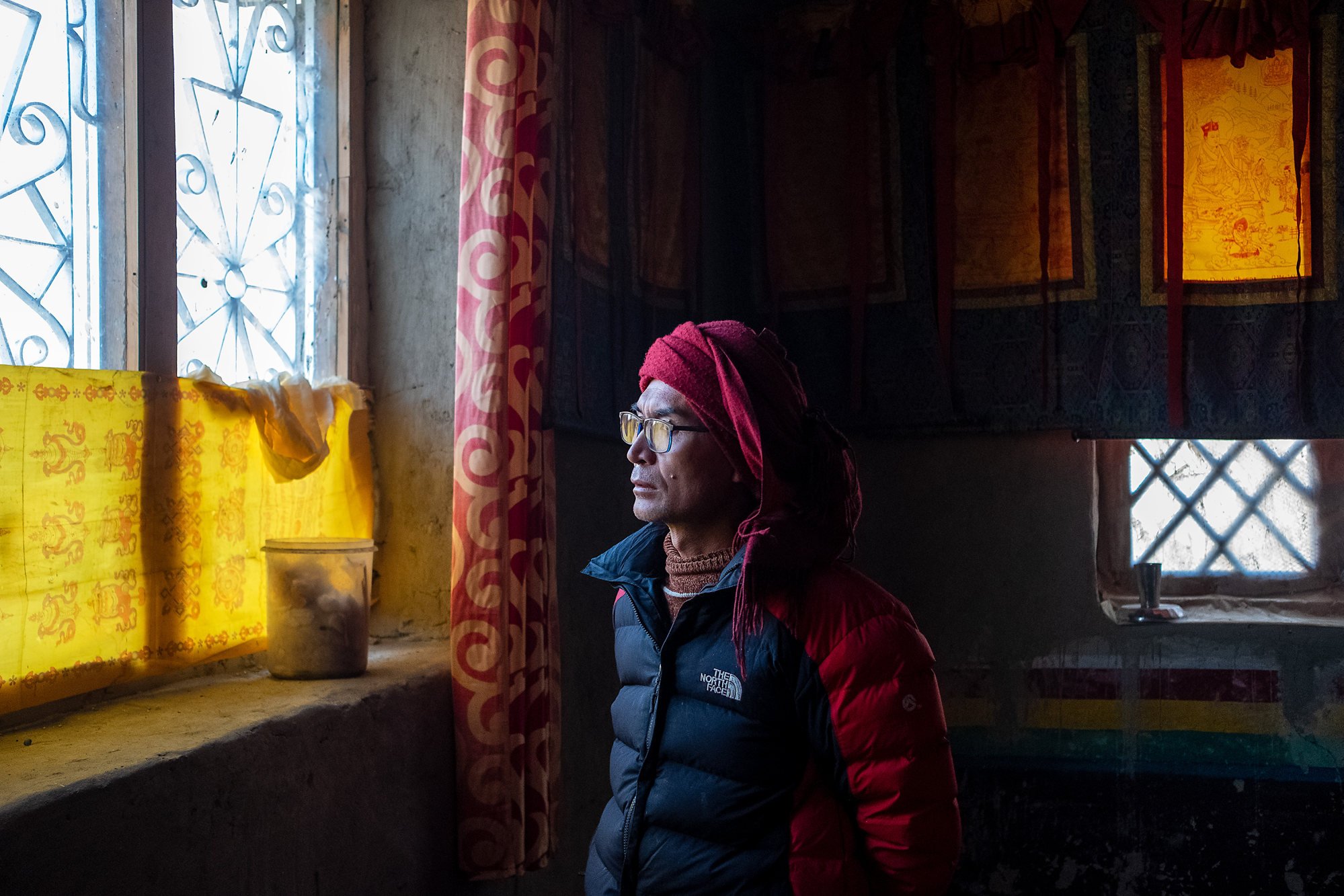
“That’s Tibet,” he says.
We want to spend longer exploring, but while these May mornings are clear, by lunchtime, clouds have covered the sky and several days of bad weather have been forecast, so we decide to return down Phu’s intimidating gorge.
The rain holds off until we reach the firm, level ground of Chyakhu, but then the heavens open. Wet and cold, we arrive an hour later at a small settlement of herders’ huts, smoke billowing from one of the chimneys.
As if we’re old friends, a goat herder pulls open the waist-high wooden door and ushers us inside. She adds wood to the hearth and sets a blackened kettle above the flames.

As the rain falls outside, Pema Lama tells us that, for centuries, Nar and Phu were hidden, unknown even to those in the next valley. Wayward yaks brought others to these lost valleys but the two villages still communicate in a tongue that is unintelligible to outsiders.
On the day we reach Nar the locals are busy preparing their fields for planting. Two women, their bare feet deep in mud, pause to chat. Life is hard, they tell us: “If you worked this hard anywhere else we would have too much food.”
We secure the last rooms available at another basic family guest house, set around a neat lawn. As in Phu, the mornings are clear, and we bask in the sun on the grass. But by the afternoon, snowstorms arrive to buffet the ancient stone houses and there is little to do other than huddle by the kitchen fire.
We’re told there are only four months when it doesn’t snow (although it still rains) and it seems the villagers work in the fields whatever the weather. Indeed, the tiny wooden windows and firewood stockpiles point to an ingrained tolerance for the weather.
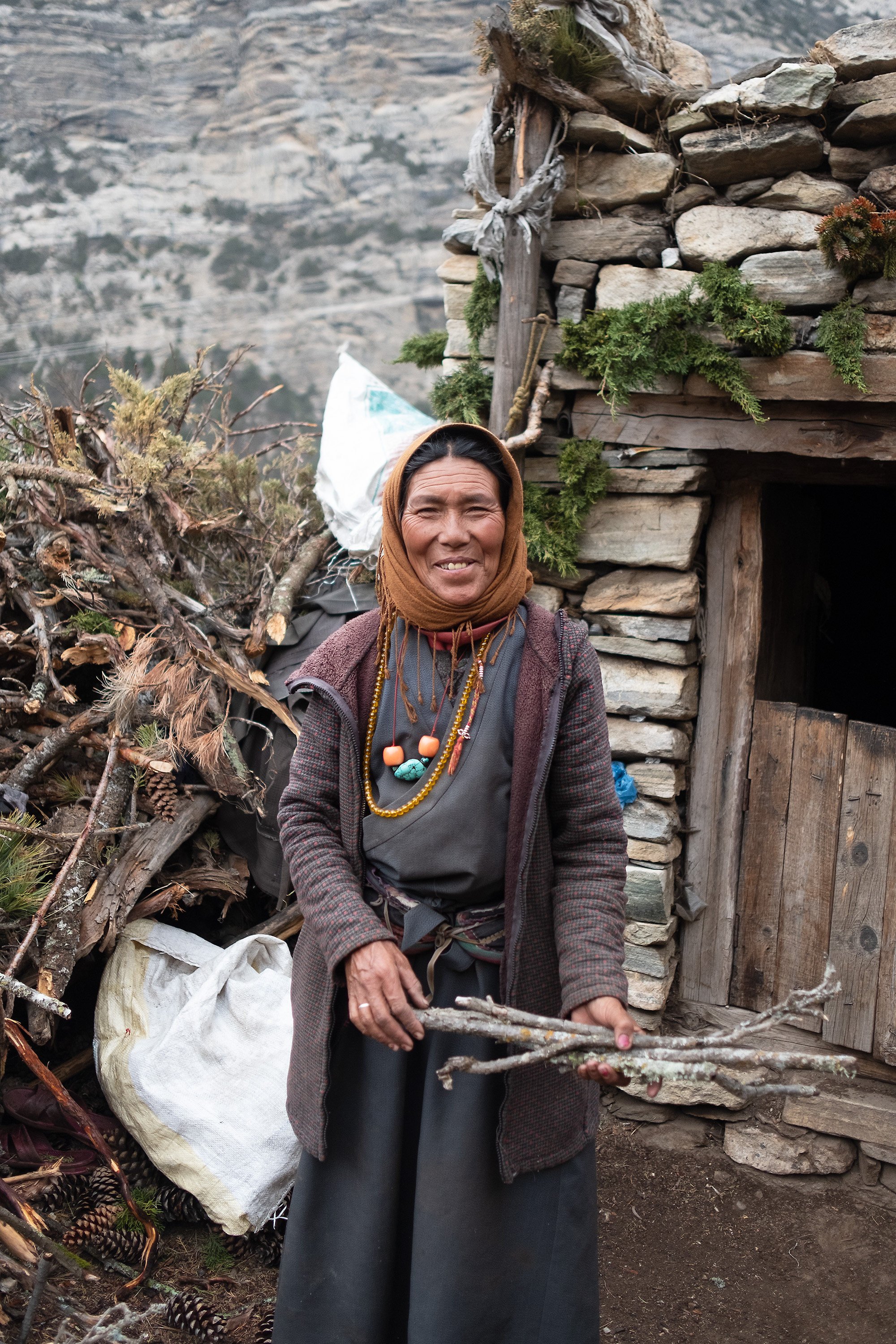
We are less accustomed and decide it is time to move down. Now there is only a 5,320-metre pass between us and the Nyshang Valley, where the Nar-Phu trail rejoins the Annapurna Circuit.
Setting off at first light, we progress quickly up the gentle incline of the valley. Soon, though, we are walking in snow, expending twice the energy and cursing our decision not to bring spikes.
The pass is at the cusp of a snow-filled corrie, providing the final, exhilarating test of the Nar-Phu trail.
From the Kang La, layers of grey and white extend behind us into the distance of the Nar Valley. Majestic white mountains stand stately on either side of it. Nar is not in sight. It is 11am, and I wonder whether, despite the clear skies, today the cloud and snow will again engulf the village and its hardy people.
I turn and trudge, with some relief, downwards towards Nyshang.
Stay connected with us on social media platform for instant update click here to join our Twitter, & Facebook
We are now on Telegram. Click here to join our channel (@TechiUpdate) and stay updated with the latest Technology headlines.
For all the latest Travel News Click Here
